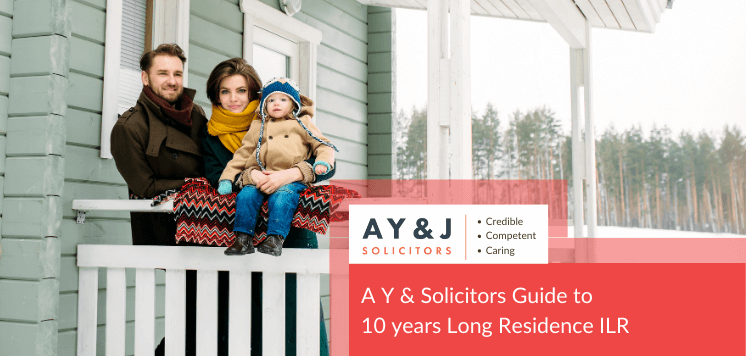Disclaimer: The information in this blog is accurate as of its publication date. Any updates after that date are not reflected here.
Many migrants who have been living in the UK for many years are not aware that it is possible to apply for Indefinite Leave to Remain (ILR) (i.e. permanent settlement) after 10 years in the UK if they have held several different types of immigration permission during that time. In most cases, ILR is gained by living continuously in the UK on a qualifying visa (e.g. a Skilled Worker visa or Spouse visa) for 5 years or less, but the 10-year ILR option provides a pathway who have not held a qualifying visa for sufficient time. In this article, we will take a closer look at the 10-year-long residence route to ILR, including the rules, eligibility criteria, and how to apply.
10-year long residence route
The 10-year-long residence route provides a way for migrants who have been living in the UK lawfully to gain ILR no matter the type of visa they have held during this time. With ILR, you will be able to live indefinitely in the UK, work, run a business, and study without restrictions. In addition, you may be able to claim for benefits that you were not previously eligible for.
The 10-year-long residence route to ILR is particularly beneficial for individuals who have been in the UK on a visa that does not count towards settlement (e.g. a student visa) or those who have changed visa type. Changing visa type can mean that the clock is ‘reset’ on any ILR qualifying time spent in the UK (e.g. a person who switches from a work visa to a spouse visa effectively starts at zero in terms of the qualifying time needed for ILR).
What are the qualifying criteria for the 10-year-long residence route to ILR?
The immigration rules state that to qualify for ILR under the long residence route, you must meet the following eligibility criteria:
- have been living for at least 10 years continuously and lawfully in the UK
- granting leave must be in the public good
- meet the English language requirements
- pass the Life in the UK test
- not meet any grounds for refusal (e.g. criminality or breaches of the immigration rules)
To meet the 10-year continuous residence requirement, you will need to demonstrate that you have lived here continuously. This means that you must not have been outside of the UK for more than 180 days at a time the 10-year period. Your period of continuous residence will also be broken if you have spent more than 540 days overall outside of the UK during the 10 years. It can also be broken where a person receives a custodial sentence and is sent to prison, a young offender institution, or a secure hospital. In addition, you cannot include time spent living in Ireland, the Isle of Man or the Channel Islands.
Crucially, you must have held a valid form of leave (i.e. immigration permission to stay) throughout the 10-year period, and you must have existing valid leave when you apply for ILR. This may include those with:
- leave to enter or remain
- temporary admission or immigration bail if followed by a grant of leave
- time spent exempt from immigration control (such as diplomats)
In most cases, if you have overstayed your visa during the 10-year period, your continuous residence will be deemed broken. There are exceptions, for example, if you have overstayed for no more than 28 days and this was prior to 24th November 2016. For a period of overstaying after 24th November 2016, leave following the overstay must have been subsequently granted under paragraph 39E, for the overstay to be overlooked.
Beyond the continuous and lawful residence requirement, you will need to demonstrate that you have sufficient knowledge of the English language. You can meet this requirement in a number of ways including by passing an approved English language test at CEFR level English qualification at a minimum of B1 level. You will also need to pass the Life in the UK test before applying for ILR.
How do I apply for a 10-year-long residence ILR?
You can apply for ILR under the long residence route up to 28 days before you meet the 10-year continuous residence period. It is important not to apply too early as there is a chance of refusal if the Home Office calculate that you don’t quite yet meet the requirement. It is always advisable to check with an immigration lawyer before you submit your application to ensure that you have worked out your period of residence correctly.
Your application for 10-year long residence ILR can be completed online on the UKVI website. You will need to pay the application fee of £2,404, however, you will not be required to pay the healthcare surcharge as you will have full access to the NHS as a settled person. During the application process, you will be asked to book and attend an appointment at a local UKVCAS service point to have your fingerprints scanned and your photo taken (your biometrics). UKVI will also request a number of documents to prove your eligibility for long residence ILR, including your current passport and all other passports held while in the UK and your current biometric residence permit (BRP).
Once you have completed the above steps, you will normally receive a decision within 6 months. If you require a faster decision, you may be able to pay an extra fee of £800 for the super-priority service, which will provide a decision by the end of the next working day.
Court confirms time spent in UK as (39E) overstayer does not count towards the 10 year period
When assessing whether you meet the 10-year lawful residence requirement, it may be important to bear in mind a recent decision by the Court of Appeal in R (on the application of Afzal) v Secretary of State for the Home Department [2021] EWCA Civ 1909. In this case, the Home Office argued that time spent in the UK under paragraph 39E should not count towards the 10-year lawful residence requirement. Paragraph 39E states that where an immigration application is made within 14 days of their leave expiring (with a good reason for the out-of-time application), or within 14 days of a visa refusal or rejection, the period of overstaying will be overlooked.
In the Afzal judgement, the Court agreed that time spent in the UK under paragraph 39E of the Immigration Rules would not break continuity of residence or “restart the clock” for a Long Residence ILR application, but that period of time as an overstayer cannot count towards the ten years needed for the 10-year long residence route.
Statement of Changes to Immigration Rules (HC1160, 9 March 2023) confirms that time spent in the UK on Immigration Bail, as Visitor, Seaonal Worker or as a Short-Term Student does not count towards the 10 year period
On 9 March 2023, a statement of changes to the immigration rules was published confirming that the immigration rules will no longer allow time spent on Immigration Bail, as a Visitor, a Sesonal Worker, or as a Short-Term Student towards the qualifying period for Long Residence ILR. The Home Office’s explanation for the change is that these are temporary visas (less than 12 months’ permission) or “precarious” forms of leave (in the case of Immigration Bail), and so the time spent under these categories should not be counted towards the 10 year period for ILR. The impact on applicants is that their continuity of residence is not necessarily broken by these periods (the clock does not “restart”) but someone who has spent time under these categories will need to wait longer to apply for ILR. This change will be effective for Long Residence ILR applications made on or after 13 April 2023.
Final words
The 10 year long residence route to ILR is extremely beneficial for anyone who has spent many years living in the UK on a mixture of different visa types or other forms of immigration permission. It is always important to carefully calculate your length of continuous residence in the UK and gather the correct evidence to back up your calculations. Even a small miscalculation can lead to the refusal of your long residence application. By seeking the advice of an immigration Solicitor, you can be sure that your application is correct, allowing you to relax in the knowledge that you have done all you can to receive a positive decision from the Home Office.
A Y & J Solicitors is a specialist immigration law firm with extensive experience with all types of visa applications. We have an in-depth understanding of immigration law and are professional and results-focused. For assistance with your visa application or any other UK immigration law concerns, please contact us on +44 20 7404 7933 or at contact us today. We’re here to help!








